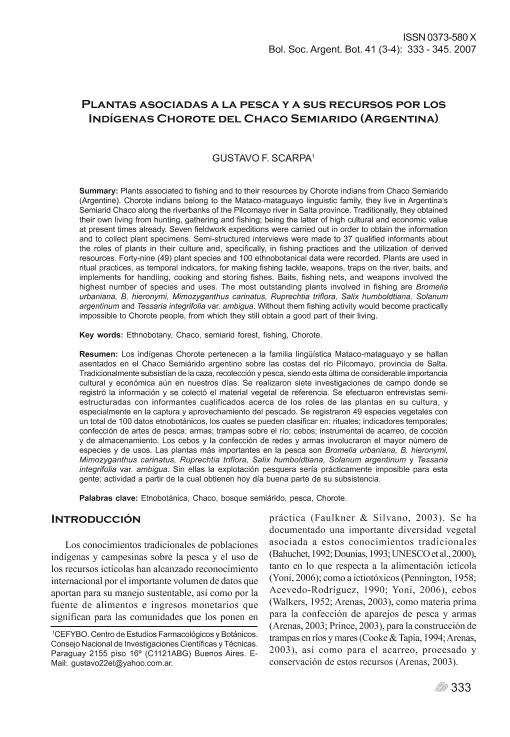Mostrar el registro sencillo del ítem
dc.contributor.author
Scarpa, Gustavo Fabian

dc.date.available
2017-07-12T22:14:27Z
dc.date.issued
2007-12
dc.identifier.citation
Scarpa, Gustavo Fabian; Plantas asociadas a la pesca y a sus recursos por los Indígenas Chorote del Chaco Semiárido (Argentina); Sociedad Argentina de Botánica; Boletín de la Sociedad Argentina de Botánica; 42; 3-4; 12-2007; 333-345
dc.identifier.issn
0373-580X
dc.identifier.uri
http://hdl.handle.net/11336/20317
dc.description.abstract
Los indígenas Chorote pertenecen a la familia lingüística Mataco-mataguayo y se hallan asentados en el Chaco Semiárido argentino sobre las costas del río Pilcomayo, provincia de Salta. Tradicionalmente subsistían de la caza, recolección y pesca, siendo esta última de considerable importancia cultural y económica aún en nuestros días. Se realizaron siete investigaciones de campo donde se registró la información y se colectó el material vegetal de referencia. Se efectuaron entrevistas semi-estructuradas con informantes cualificados acerca de los roles de las plantas en su cultura, y especialmente en la captura y aprovechamiento del pescado. Se registraron 49 especies vegetales con un total de 100 datos etnobotánicos, los cuales se pueden clasificar en: rituales; indicadores temporales; confección de artes de pesca; armas; trampas sobre el río; cebos; instrumental de acarreo, de cocción y de almacenamiento. Los cebos y la confección de redes y armas involucraron el mayor número de especies y de usos. Las plantas más importantes en la pesca son Bromelia urbaniana, B. hieronymi, Mimozyganthus carinatus, Ruprechtia triflora, Salix humboldtiana, Solanum argentinum y Tessaria integrifolia var. ambigua . Sin ellas la explotación pesquera sería prácticamente imposible para esta gente; actividad a partir de la cual obtienen hoy día buena parte de su subsistencia.
dc.description.abstract
Chorote indians belong to the Mataco-mataguayo linguistic family, they live in Argentina's Semiarid Chaco along the riverbanks of the Pilcomayo river in Salta province. Traditionally, they obtained their own living from hunting, gathering and fishing; being the latter of high cultural and economic value at present times already. Seven fieldwork expeditions were carried out in order to obtain the information and to collect plant specimens. Semi-structured interviews were made to 37 qualified informants about the roles of plants in their culture and, specifically, in fishing practices and the utilization of derived resources. Forty-nine (49) plant species and 100 ethnobotanical data were recorded. Plants are used in ritual practices, as temporal indicators, for making fishing tackle, weapons, traps on the river, baits, and implements for handling, cooking and storing fishes. Baits, fishing nets, and weapons involved the highest number of species and uses. The most outstanding plants involved in fishing are Bromelia urbaniana, B. hieronymi, Mimozyganthus carinatus, Ruprechtia triflora, Salix humboldtiana, Solanum argentinum and Tessaria integrifolia var. ambigua. Without them fishing activity would become practically impossible to Chorote people, from which they still obtain a good part of their living.
dc.format
application/pdf
dc.language.iso
eng
dc.publisher
Sociedad Argentina de Botánica

dc.rights
info:eu-repo/semantics/openAccess
dc.rights.uri
https://creativecommons.org/licenses/by-nc/2.5/ar/
dc.subject
Etnobotánica
dc.subject
Chaco
dc.subject
Bosque Semiárido
dc.subject
Pesca
dc.subject
Chorote
dc.subject.classification
Antropología, Etnología

dc.subject.classification
Sociología

dc.subject.classification
CIENCIAS SOCIALES

dc.title
Plantas asociadas a la pesca y a sus recursos por los Indígenas Chorote del Chaco Semiárido (Argentina)
dc.title
Plants associated to fishing and to their resources by Chorote indians from Chaco Semiarido (Argentine)
dc.type
info:eu-repo/semantics/article
dc.type
info:ar-repo/semantics/artículo
dc.type
info:eu-repo/semantics/publishedVersion
dc.date.updated
2017-07-11T19:46:19Z
dc.identifier.eissn
1851-2372
dc.journal.volume
42
dc.journal.number
3-4
dc.journal.pagination
333-345
dc.journal.pais
Argentina

dc.journal.ciudad
Córdoba
dc.description.fil
Fil: Scarpa, Gustavo Fabian. Consejo Nacional de Investigaciones Científicas y Técnicas. Oficina de Coordinación Administrativa Houssay. Centro de Estudios Farmacológicos y Botánicos. Universidad de Buenos Aires. Facultad de Medicina. Centro de Estudios Farmacológicos y Botánicos; Argentina
dc.journal.title
Boletín de la Sociedad Argentina de Botánica

dc.relation.alternativeid
info:eu-repo/semantics/altIdentifier/url/http://ref.scielo.org/k8mffp
Archivos asociados
